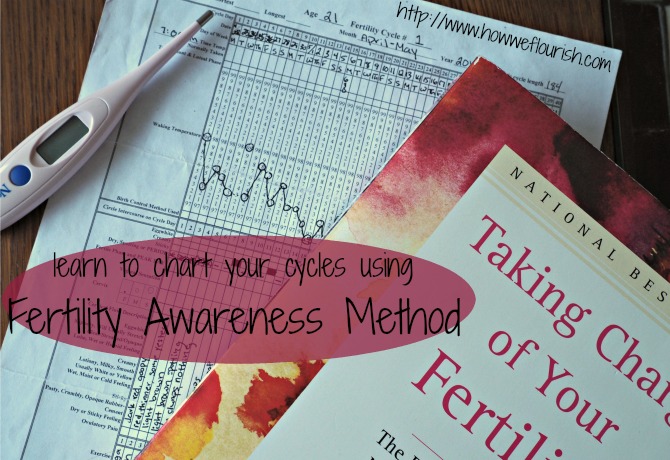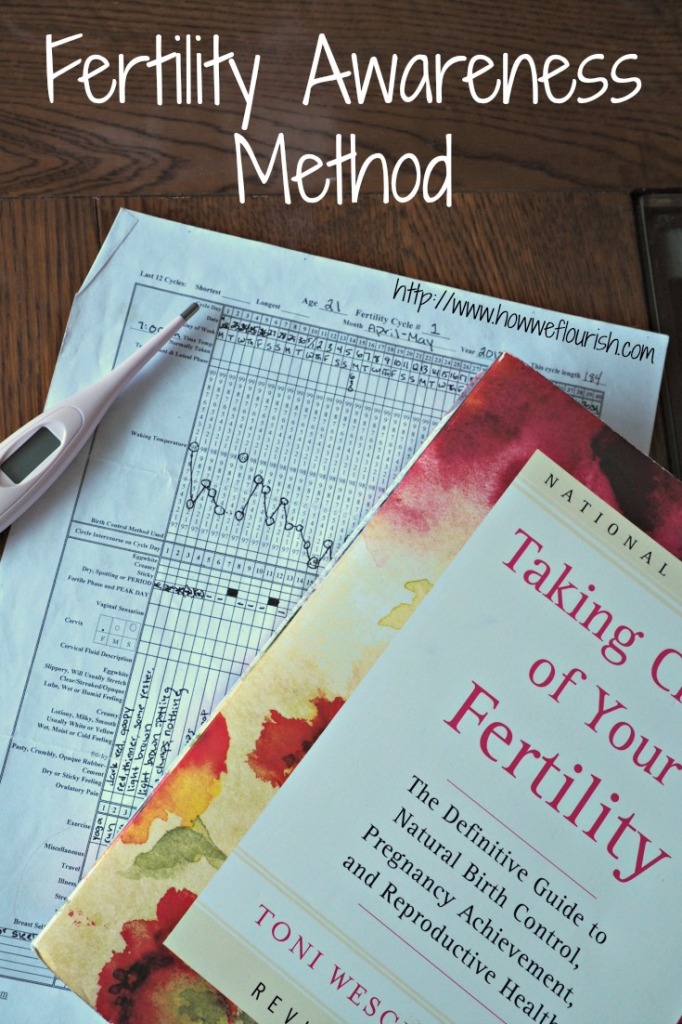I may receive a commission if you purchase something mentioned in this post. See more details here.
I have been charting my cycles for 21 months now. I use a combination of a few different charting methods, one of which is called Fertility Awareness Method (FAM).
I have written about Natural Family Planning (NFP) in the past. Please consult this article for information on using this method as birth control. But whatever you are seeking, I strongly believe that every woman should be charting her cycles. It brings knowledge, empowerment, and health and I cannot sing the praises of charting enough. But how do you do it?
There are many options to choose from: Fertility Awareness Method, Creighton Model, Billings Ovulation Method, Sympto-Thermal, Justisse, Natural Family Planning etc. Where do you start?
For many women, they will choose their method of charting based on what is most easily accessibly to them. I have been very lucky in that I have learned 3 different methods of charting, which I will be sharing with you over the next few weeks. The first method I learned about is the Fertility Awareness Method.
What is the Fertility Awareness Method?
Also known as FAM, Fertility Awareness Method and Sympto-Thermal Method (STM) are two names for one of the natural methods of family planning. The woman charts her cycles based on a variety of fertility symptoms. Basal body temperature (BBT) and cervical mucus are necessary parts of charting, while cervical position and a variety of secondary symptoms can also be used to determine fertility.
Many Catholic churches offer classes on STM to their parishioners, and searching there will likely be your best option for personal instruction. However, it is extremely easy to self-teach FAM using my favorite book: Taking Charge of Your Fertility. Whether you are trying to conceive, trying to avoid, or simply want to learn more about your body, Taking Charge of Your Fertility is a must have on the bookshelf of all women. In this book, you will find detailed instructions on how to chart your symptoms of fertility and how to interpret what you find. Written from a secular perspective, it is entirely science based and makes no moral arguments for NFP. Instead, it simply explains why the Fertility Awareness Method is the healthiest and one of the most effective methods of family planning (estimated at around 98% effective).

Isn’t this just the Rhythm Method?
I’m going to address this is every post I write about charting until people stop believe this. FERTILITY AWARENESS IS NOT THE RHYTHM METHOD!
The Rhythm Method and the Standard Days Method are two antiquated methods of natural family planning that are no longer endorsed by the scientific community, the natural community, or even the Church. These methods involve using past cycle lengths and counting to estimate when a woman will ovulate and determine her fertility that way. You can see why this neither works for avoiding pregnancy OR conceiving. These methods pay no mind to when a woman is actually ovulating. Not only may she have a shorter or longer than average luteal phase (making counting backwards an incorrect estimate), but it only relies on averages. If the woman were to ovulate earlier or later than usual, her estimated date of ovulation would be totally wrong! Her timing of intercourse would likely result in the exact opposite of what she was hoping for.
So how is Fertility Awareness different? While many women use data from past cycles to help them understand what is going on and anticipate, decisions about when to have sex in a given cycle are based on data collected from that cycle. There is no guessing when ovulation occurred. Rather, the woman carefully tracks her fertility signs to determine whether she is fertile that particular day. She and her partner then have the information and the power to decide if they are comfortable having sex.
The Signs of Fertility Awareness Method
So what signs do you track and how do they tell you if you are fertile? Really, you will get the best explanation from reading Taking Charge of Your Fertility. If you are considering FAM, go and pick up this book and read it.
The primary signs tracked are basal body temperature (BBT) and cervical mucus. Using a BBT thermometer (I use this one – it beeps so that I know I am keeping it positioned properly), the woman takes her temperature every morning upon waking. Ideally this will be at the same time every day after a few hours of uninterrupted sleep. You will learn how sensitive your body is to various conditions. After ovulation, your BBT will rise and stay elevated until your next period starts.
The sign that is hard for a lot of women to start checking is cervical mucus. You can check this internally, externally, or even off of toilet paper. Checking for mucus at the cervix will give the most accurate and current information, but do whatever you are comfortable with. Just be consistent. Cervical mucus should be checked every time you go to the bathroom.
You will notice that it is non-existent or sticky at the beginning and end of your cycle, and has a more egg white consistency around ovulation. This egg white consistency is very friendly to sperm. It helps move them through the cervix and can keep them alive for 5 days or even longer! When trying to avoid pregnancy, do not have sex with egg white mucus!
Generally the woman will see this mucus dry up once ovulation occurs, but it is important to beware of “double peaks.” This occurs when the body gears up to ovulate, but does not for whatever reason. The cervical mucus will dry up, but then return awhile later when the body attempts to ovulate again. No temperature rise will be seen unless ovulation occurs, so it is very helpful to use the both of these signs together.
The woman can also track her cervical position. This can be difficult for many women, and is not necessary. However, it can give useful information as you feel the position and hardness of your cervix change over the course of the cycle. Some women will also notice ovulation pain, breast tenderness, cravings, and other secondary symptoms around the time of ovulation. While these should not be relied on alone to determine ovulation, it can be helpful to make not of these.
The following picture shows my temp and mucus charting during one of my anovulatory cycles:

This sounds like a lot of work…
The Fertility Awareness Method can be daunting for a lot of women to take on. Many completely reject the idea because it is too much work. I’m here to tell you – it’s not! It takes me just minutes a day to measure and chart all of my symptoms. After a few cycles, everything will become habit and you will be able to look at your charts and know what is going on.
I set an alarm to remind me to take my temperature at the same time every morning. I don’t even know how long this takes, because I often begin to fall back asleep as I take it. I check my mucus whenever I am going to to bathroom. That takes no time. I’m down there anyway! At the end of the day I record everything on my chart, which is just the time it takes to circle a number, color in a box, and check off any symptoms I noticed. Easy peasy.
The hardest part of the Fertility Awareness Method will be learning how to interpret your charts. For this reason, if you are trying to avoid pregnancy, it is recommended that you have a few months of charting under your belt before you have unprotected sex. Thankfully, Taking Charge of Your Fertility will help you figure this out. Even better, the TCOYF website has an amazing forum full of very knowledgeable women who have been charting their cycles for years. I highly recommend these forums for any questions you may have about FAM, as well as to receive support from other women on the same journey as you.
But regardless of the effort, learning to chart your cycles is completely worth it. As I have dealt with irregular or missing periods over the past 21 months, it has allowed me to keep tabs on how my cycles are progressing. It gives me a natural for of birth control that I feel safe using despite these irregular cycles – and I always know the reason for my late or missing periods (hint: it’s not pregnancy!). I always know when my next period will start, even though my cycles are never the same length. With a woman’s health being so closely tied to her fertility, why wouldn’t you want to know more about your own body?
I hope that you will consider learning more about Fertility Awareness Method, and that you will stay tuned to hear more about other charting methods. If you have any questions, I would love to answer them!
Do you use the Fertility Awareness Method, or any other method of Natural Family Planning? If not, would you try it?
Pin it:
 Shared at Wildcrafting Wednesdays and Simple Lives Thursday.
Shared at Wildcrafting Wednesdays and Simple Lives Thursday.
Like what you see? Please support this blog and help me keep it running by signing up for my newsletter, purchasing products, or donating through the links below:
DISCLOSURE: In order for me to support my blogging activities, I may receive monetary compensation or other types of remuneration for my endorsement, recommendation, testimonial and/or link to any products or services from this blog. The information contained in this post is not intended nor implied to be a substitute for professional medical advice, it is provided for educational purposes only. You assume full responsibility for how you choose to use this information. For more information, click here.



Conceived my twins with this book’s help. <3
FAM is one of the best things that ever happened to me! After 18 years of HBC I am so happy to have been rid of it and using FAM for a whole year! So glad you are sharing this with other women, Chloe!
Thank you so much! So happy that you have been using FAM for a whole year!
I think the biggest thing I loved about charting was learning SO much about my body – it is empowering.
I agree! Especially with irregular cycles like I have, what you learn from charting is invaluable.
I have irregular cycles and just discovered FAM, since we are wanting to ttc in a few months. Do you have any advice for a new comer to charting and for someone who just came off of HBC?
First off, I always suggest getting an instructor or reading Taking Charge of Your Fertility. Knowing what you are looking for and getting started tracking is the first step! It’s likely that your cycles will be irregular at first or may take awhile to come back – or you may go right into normal cycles.
Thank you so much for sharing this! We are pinning it! Looking forward to your other posts in this series!
Thank you!
I loved that book too!! I found it when I got off the pill and we wanted to have our first. It is so well-written and elucidating!
I used a similar method years ago and found it quite reliable! (Did I mention I had six babies in ten years:)
Wow, so much info here! I have been learning about this gradually and it’s pretty amazing how in tune it helps you feel with your body.
I have that book too. Love it!
This is one of my all time favorite fertility books. Such great information. I think every woman should chart at one point in her life just to learn how her body works.
I totally agree!
Love this post! We have been “trying” since last July with no success, and although I started tracking my ovulation and cervical mucous, I decided it was too much on me and it really just wasn’t the right time.
I can imagine that it would be hard in that case. Good luck!
Great post Chloe! My sister is getting married this summer and they have hopes of trying to start their family right away. I’ll share this post with her!
Thank you! And best wishes to your sister.
Do you mind sharing if the book discusses fertility awareness method for women with an irregular sleep pattern. I work night shift and I am hoping to start using FAM when I have my mirena removed next month, but I would hate to invest money into this method if it simply won’t work for me. Thanks!
There are many options for people with irregular sleep pattern, although they are not all discussed in the book. Some women use a mucus only method like Billings or Creighton. Some take their temperature at some point in the evening, which can be done by relaxing (reading a book, etc.) for at least half an hour with no food or drink. Some people who do shift work have no problem seeing a temp shift just by taking their temperature when they wake up from restful sleep, while others cannot. BBT thermometers are fairly cheap, so it may be worth it to you to try it out. Otherwise, the book still is full of extremely helpful information for charting fertility markers other than temperature and I would recommend reading it.
Hi Chloe,
Thanks for this great article. I’ve been meaning to start practicing natural contraception for a while now but I feel that my hormones are still out of whack so I’ve been putting it off. Does it work effectively even if your hormones are not balanced?
Yes, it does. My hormones have been out of wack for 2 1/2 years. In fact, if it were not for fertility awareness, I would never know the status of my hormones or when my periods were coming. Now, I can almost always predict my periods, despite every single cycle being a different length! It requires diligence, of course, to interpret irregular cycles for avoiding pregnancy, but many woman do it. I am one of them.
That’s awesome, thanks for the reply. That gives me the confidence to get started… Just purchased ‘taking charge of your fertility’ 🙂
Awesome! I hope you love it. It’s an amazing book.